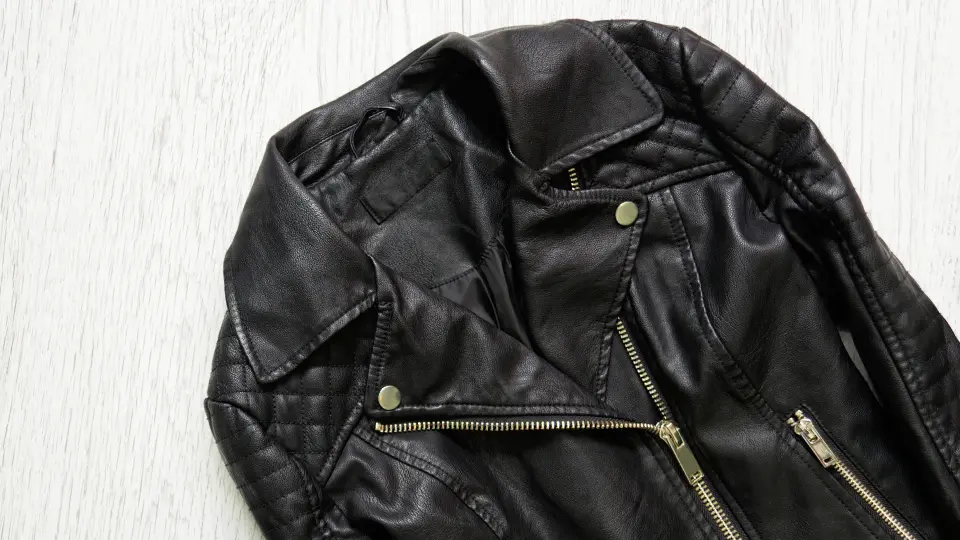How To Protect & Care For Your Leather Jacket
Leather jackets became highly popular in the 1950s when Hollywood actors began to don the jacket to emulate the rugged military look. Whether you have a classic leather jacket or a bedazzled leather coat, you need to take care of it so that you can use it for years to come.
Some leather jackets can lose their shine over time as dust, grime, sweat, and body oils deposit on them. If leather jackets are not maintained and cared for regularly, they may lose their appeal, and color, eventually becoming stiff.
Leather jackets can also dry out and develop cracks if they aren’t well cared for. Therefore, if you want your leather jacket to maintain its pristine, smooth, and glossy condition, you must follow proper leather care instructions.
The best way to protect and care for your leather jacket is to clean, condition, protect, and store your jacket appropriately so that it’ll last for years to come. This article covers how you can do so confidently.
- Clean Your Leather Jacket
- Condition Your Leather Jacket
- UV Protect Your Leather Jacket
- Waterproof Your Leather Jacket
- Air Dry and Ventilate Your Leather Jacket
- Storing Your Leather Jacket Correctly
We will also inform you about what common mistakes you should avoid to prevent any unnecessary damage to the leather material of your chic jacket. Avoiding these mistakes can prolong its lifespan immensely.
1. Clean Your Leather Jacket
Leather jackets should be cleaned as need be or once every month if you wear you’re wearing them regularly. We suggest cleaning your leather jacket when you notice dirt and smudges on them and before you store them for later use.
Allowing dirt, grime, and body oils to deposit on your leather jacket for a long time can ruin the texture of the leather. Contaminants can also dull the shine of the leather material and even discolor it if you are not careful.
Therefore, you should use saddle soap or a dedicated leather cleaner to clear away any impurities from your leather jacket. You can gently apply a thin leather cleaner coat and use a soft microfiber cloth to wipe away all impurities.
2. Condition Your Leather Jacket
Conditioning is one of the most crucial steps in the leather care process since it replenishes your leather jacket with all required oil nutrients. If it’s not nourished regularly with a leather conditioner, your leather jacket may harden and develop cracks on the surface.
Unconditioned leather jackets can appear dull since it becomes vulnerable to dirt and dust, eventually losing their luster. You should condition your leather jacket once every couple of months or after every leather cleaning session.
Conditioning leather is a must after exposure to water and constant sunlight since it restores the natural oils that dissolve and evaporate with the water or that dry up from sunlight.
After applying a coat of leather conditioner with a lint-free cloth, use circular motions and adequate pressure to spread the conditioner around evenly. Then, wipe away the excess product and let your leather jacket dry naturally. This helps to protect your leather coat from impurities.
3. UV Protect Your Leather Jacket
Harsh ultraviolet (UV) rays from sunlight can significantly damage the leather material of your jacket. It can fade its glossy and vibrant color, causing it to look brittle, dry, and discolored.
Continual exposure to harsh sunlight can cause your leather jacket to develop cracks and weaken the fibers inside. Therefore, you need a quality UV protectant for your leather jacket for its durability.
To choose a quality leather UV protectant, you need to find a suitable product that works with the specific leather material of your jacket. The product should also have a similar pH balance with the leather material or at least be pH neutral.
You can apply a leather UV protectant by wiping your leather jacket with a soft cloth containing the formula. Ensure to cover the entire surface of the leather jacket, especially parts that are exposed to the sun most often (shoulders, arms, back, etc.).
4. Waterproof Your Leather Jacket
If your leather jacket is exposed to water or rain regularly, then you should consider waterproofing your leather jacket. You can do this by simply selecting a suitable waterproofing wax or solution, that is designed for leather use.
Evenly apply the waterproofing solution onto your leather jacket and use a lint-free cloth evenly coat it. Ensure to use moderate pressure and cover the entire leather jacket. We only recommend a thin waterproofing layer, as a leather conditioner already adds a protective layer.
Moreover, if the waterproofing layer is too thick, it may inhibit the leather’s breathability. Feel free to refer to our detailed article on how water and leather interact.
5. Air Dry Your Leather Jacket
Air drying leather jacket after cleaning, conditioning, and waterproofing is the best drying method for leather. You can use towels first to absorb excess moisture before air drying it. We recommend hanging your leather jacket with a clothes hanger and drying it in a dry, cool, and shaded spot.
Drying leather in sunlight can lead to cracks and further UV damage, so it’s best to avoid it. You can use a hairdryer to speed up the process, but it must be in the coolest setting to avoid any warping of your jacket due to the heat.
6. Store Your Leather Jacket Adequately
Leather jacket storage is tricky since the sensitive properties of leather require you to take a few extra precautions before storing. After conditioning, and optionally UV protecting and waterproofing your leather jacket, you should choose a wide wooden hanger to hang and store it.
The width of the hanger should be sufficient to ensure that the shoulders of your jacket don’t droop and the jacket maintains its shape over time. The jacket should be stored inside a fabric or garment bag in a clean, dry, and cool closet.
This is not dissimilar to how you should be storing structured blazers and suit jackets. You can also store it inside a wooden trunk or suitcase. However, a fabric bag is preferred due to its allowance of the leather material to breathe, keeping the leather jacket pristine for future use.
If you have multiple zippers or pockets in your leather jackets, you can insert paper towels or tissue paper inside to offer extra protection and help it maintain its shape. Also, remember to regularly ventilate your wardrobe to get fresh air in.
Common Mistakes Around Leather Jacket Care
While following these leather care tips will prolong the lifespan of your leather jacket, there are also several mistakes that you should avoid, that are regularly overlooked. Let’s explore them in more detail.
Avoid Incorrectly Waterproofing Your Leather Jacket
Waterproofing leather jackets may seem like a great idea, but some waterproofing solutions or waterproofing with a layer that’s too thick can restrict the breathability of your leather material.
Certain waterproofing formulas can fill the pores of the leather material and affect its overall quality. Therefore, we recommend applying a thin layer if any, and always ensure to read the product description of your waterproofing wax.
Avoid Washing Your Leather Jacket in Washing Machine
Washing a leather jacket in the washing machine may dry out the leather since all-natural oils may wash away in the water. It can also affect the original structure and shape of the leather jacket and cause the material to dry out.
If you aren’t confident about cleaning your leather jacket yourself or don’t have the proper materials, you should contact a professional leather cleaning service to help you take care of this.
Avoid Drying Your Leather Jacket in Dryer
Putting your leather jacket in the dryer can damage it extensively due to the high heat. It may warp the shape of your jacket and even cause it to shrink. This practice may also dry out the natural oils of leather and cause it to crack and shrivel.
Avoid Storing Your Leather Jacket Incorrectly
Storing a leather jacket on a wire or plastic hanger can cause it to wrinkle, lose its shape, and begin drooping. Therefore, you should always choose to hang a leather jacket on a sturdy wood hanger.
In addition, store it in a cool and dry environment to help retain its structure. If you store your leather jacket in a humid and warm environment, your leather jacket may develop mold due to moisture and heat.
Avoid Ironing Your Leather Jacket Incorrectly
Direct heat application on your leather jacket through an iron can scorch the material, while moisture from hot steamers can cause the leather material to lose its natural oils.
Therefore, the best tricks to iron out the wrinkles in your leather jacket are to spray a diluted rubbing alcohol solution on it, steam it in the bathroom as you shower, or use your hands to stretch out creases.
You can also iron it with a cloth or towel in between the leather jacket and your iron. Just ensure that the hot iron does not make direct contact with your leather jacket, to avoid damage.
Another great method is to use an iron at the lowest setting and place a pillowcase on top of the material before ironing your leather jacket. This will protect the leather from excess heat while providing enough warmth to straighten out creases.
Frequently Asked Questions
In this section, we’ll be taking a closer look at the most frequently asked questions regarding the protection and care of leather jackets. Please read the questions and our respective answers below.
Do I Need to UV Protect & Waterproof My Leather Jacket?
You should only consider using a UV protectant and a waterproofing wax on your leather jacket if it’s frequently exposed to direct sunlight or rain. This is because applying too many layers of product can reduce the leather’s breathability.
How Often Should I Protect & Care For My Leather Jacket?
You should care for your leather jacket by washing and conditioning it regularly. Remember to only use leather-friendly products.
Are Suede Leather Jackets Cared For Differently?
Yes, please keep in mind that suede leather jackets should not be cared for using general leather products. This is because suede has a soft texture that may get altered. Always use products that are designed for suede.

About Matthew
Co-Founder, Editor-in-Chief & Writer At Leatherskill
I’m a leather enthusiast turned artisan. Apart from crafting leather products, I’m passionate about writing in-depth guides and reviews on all things leather!

